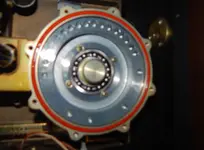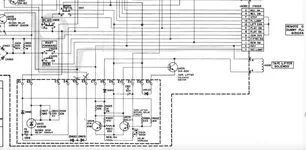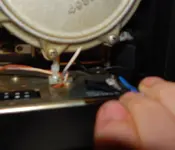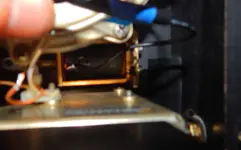The +34V is not that far off of the specified voltage…thats, like, 13% above what’s spec’ed. I wouldn’t think twice about that, particularly when the other solenoids are working fine. And no the transport power is not the same as the electronics power. The transport power supply is in the transport control box. The +39V audio power supplies are in the boxes at the bottom rear of the console. You won’t ever see transport power commingling with audio power.
The fact it is not ramping up with the solenoid disconnected does not necessarily mean the solenoid is the culprit, but that is a logical deduction. You can have a failing power supply produce full clean power unloaded, but as soon as a load is presented the voltage may drop significantly or might get really dirty. But looking at a few things related to the solenoid itself is a good place to start.
So there are non-factory wires and connections there, huh? That’s usually not great. 20~22AWG seems smaller than I remember so just look at that…don’t know if something got damaged at some point and wiring was replaced with “that’ll do” size. And solderless crimp connectors? Like butt connectors or quick disconnect bullet or spade type? Pictures would help.
I don’t know what the coil resistance is supposed to be on that solenoid, but 14R doesn’t sound wrong. I was mainly interested if it was high resistance. It’s not. And if you’re measuring the resistance across the leads of the coil that takes into account the wiring. I still would be interested in a picture and your thoughts as to whether or not the wire size of the non-factory wiring matches up with the size of the wiring powering the other relays…the pinch roller solenoid and the brake solenoids. After that I’d visually inspect the wiring in the control box. IIRC there is a small PCB in the control box with the lifter return delay trimmer on it, some transistors, resistors, diodes, caps, etc. One side of the lifter solenoid coil goes to terminal E8 on that board so follow the wiring back to that and make sure it looks okay, if anything is suspect measure for resistance…and look at the board for any compromised solder joints or otherwise.
Now…here’s the other thing…have you done anything with the plug-in “ice cube” relays on this thing? It is super-common for contacts in these to oxidize, and/or wear past their service life. Almost always these are not sealed relays so they are open to the air (albeit with a plastic cover over them), so there is arcing and sparking and carbonizing and pitting, etc. Some people like me have thought “oh I’ll just open them up, clean and burnish the contacts and on my merry way I’ll go!” No. Best case scenario after “servicing” the relays: everything works relative to the relays for a little while but problems return. Typical scenario: some things improve for a short while, but not everything, and eventually things are back where they were. Sometimes scenario: old problems remain and new problems manifest. The easiest thing to do is just get new relays. If it’s a machine one is keeping it can make sense to get the hermetically sealed relays. They last longer. I think there are a total of 12 on an AG-440B-8…I might be wrong about that…4 on the transport control box, and 1 each on the back of the signal electronics modules (those are the record relays). These are 4PDT relays. I think the coil voltage is 24V. One set of the 4 contact sets in each of the REW and FFWD relays powers the lifter solenoid. You can bench test the relays…energize the coil with +24V to close the contacts and measure the resistance across the contacts 7 & 11…it should be a dead short.
The OTHER thing to check is to make sure the EDIT switch isn’t messed up. If there is a high resistance situation between the contacts when the switch is in the up position, the system could perceive the transport is sort of in EDIT mode, which includes a lifter cancel function. So you could temporarily bypass terminals A & C of the switch to rule that out. If you bypass those terminals (i.e. put a temporary jumper in place), and it works, the switch should be replaced.
Hopefully that gives you some things to work on. If it was my machine I would waste no time and at least replace the relays on the transport control box with new parts. Doing that alone *usually* addresses 95% of the problems one encounters with a an AG-440 machine.




